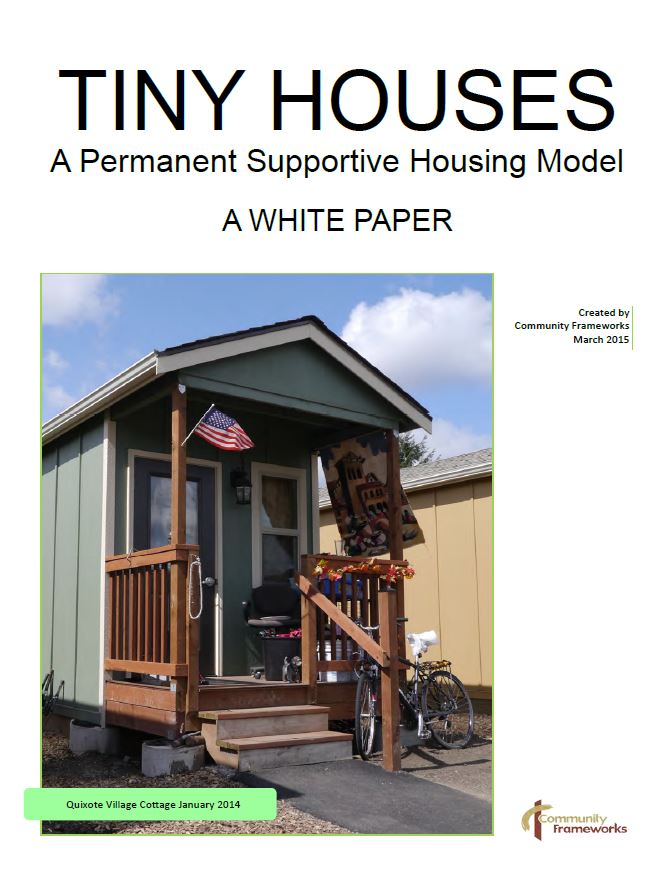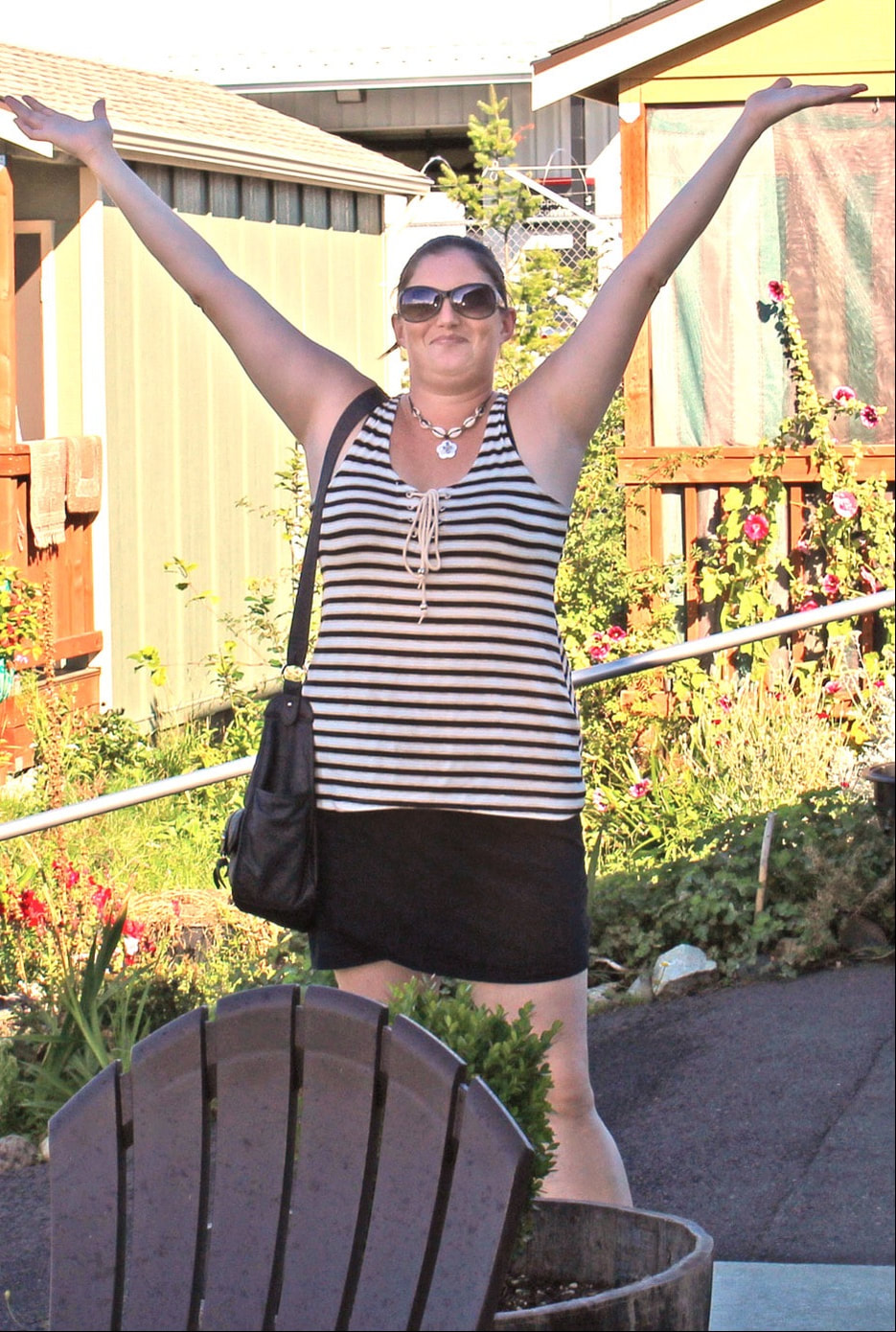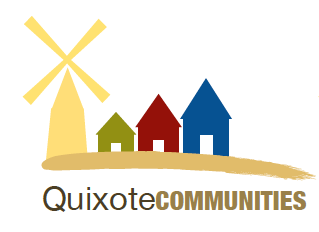Quixote Village Frequently Asked Questions
|
Interested in how to start a tiny home village in your community?

|
Who manages Quixote Village?
Quixote Village is supported by Panza dba Quixote Communities, a 501(c)3 non-profit organization (Panza was named for Sancho Panza, the servant of Don Quixote in Cervantes' novel). A Program Manager, Program Supervisor, and 2 Case Managers oversee the site. What model do you use?
How do you apply to live at Quixote Village?
The village is home to chronically homeless single adults living in Thurston County. Quixote Village is currently full. Please contact 1-844-628-7343 to get on our wait list. In general, the admission process will include an initial interview to determine eligibility. Background checks and drugs screenings are required. Residents may not have outstanding warrants and/or sex offender registration. Village residents are expected to be clean and sober. However, we understand the complexity of alcohol and substance use and work with residents on every stage of their recovery. What is in each tiny home at quixote village?
Each 144 sq. ft. tiny home consists of:
What is in the Community Center at quixote village?
How did this all get started?
It all began when Camp Quixote, a tent city, was established in downtown Olympia in 2007 to protest a city ordinance that banned lying or sitting on sidewalks in the downtown core. When police threatened to break up the camp, the homeless residents and their activist supporters, The Poor People’s Union and Bread and Roses, asked the Olympia Unitarian Universalist Congregation to provide space for the camp on the church's property. In February of 2007, the campers moved to OUUC, the first of seven local churches that would host the camp over the next six years. Eventually Olympia, Lacey, Tumwater and Thurston County were all convinced to pass ordinances permitting the camp on church properties, but requiring 24 hours a day monitoring by church members, strict adherence to health and safety rules, and limited stays at each location. Inhabitants of the camp elected a Resident Council that defined the rules of residency, made sure they were being followed and was in charge of admissions. Overseeing the camp and moving it from one church parking lot to another every three to six months was no easy task! Hundreds of volunteers helped with donations, security, finances, and transportation. We are forever grateful to them and to the faith communities that offered the camp support, including sanctuary on their land. Along the way Panza, a nonprofit organization, was created to support the camp. The founders of Camp Quixote hoped to find land and build a permanent village for themselves, consisting of tiny houses and a shared building that would house showers, laundry, and cooking facilities. In time, with support from the City of Olympia and Thurston County, as well as our many volunteers and the camp residents themselves, Panza began to advocate for a permanent solution. A LOT of hard work ensued: a campaign for funding was launched, a search for a site undertaken, changes in city code were needed (because there was nothing written in policy for single units that share a common space!) and a conditional use permit obtained. We held multiple open forums to educate the community on who we are and what they could expect. Eventually Panza cobbled together funding from federal, state and local sources to make this vision a reality on a site provided by Thurston County for $1 a year, for 41 years. Construction began. On December 24, 2013, the 30 residents of Camp Quixote left their tents behind and became residents of Quixote Village. Check out our blog for more info! What did it cost?
The total cost to build Quixote Village, including 30 tiny homes, two of which are ADA compliant, and the community center was $3.05 million. This includes all pre-development costs (architect, engineering, etc.), infrastructure, materials, labor, permits, fees, required road and storm water improvements, and the value of the land. Thurston County leased us the site, estimated at a $333,000 value, for $1 a year for 41 years. Substantial services were donated by our architect, our civil engineer, and others. The actual cost of construction (materials and labor) for each cottage was about $19,000. The cottages are permanently installed on sunken piers and have electricity, heating and running water (toilet and sink). The total cost of the Village, including donated land and services, divided by the number of cottages yields a per unit cost of $101,567. This compares favorably to the estimated average cost per unit for low-income studio apartments of $200,000. Moreover, when the value of the donated land and services is subtracted, what we actually PAID for the Village was just under $88,000 per unit. Where did the money come from?
How did Panza and Camp Quixote raise the money?
The local ordinances that regulated Camp Quixote required that volunteers staff a “host desk” to control entry into the Camp and ensure safety. This meant that over the years, hundreds of faith community members and others who served as volunteers got to know people who were homeless. It was a transformative experience for everyone, volunteers and Camp residents alike, most of whom had been strangers to each other before. The result was a remarkable coalition. When 100 or more people from diverse faith communities and 30 people living in tents packed city council meetings, council members took notice. This coalition was further strengthened by the support of local environmentalists who welcomed the idea of tiny house development. The Thurston County Commission was an early supporter of the Village idea, and saw it as a promising model for affordable, sustainable housing. Their early commitment of land for the Village was an important first step towards raising the money to build it. Camp residents and Panza members testified in support of a state capital budget appropriation and won a $1.5 million commitment from the state. Once we had that first big commitment, others followed. Panza hired Community Frameworks, a non-profit low-income housing development agency based in Bremerton, Washington, to guide us through the complex processes involved in government grant applications and funding, and to manage the construction financing. The keys to our fundraising success were: Residents of the Camp proved they were capable of self-government, and over time they built a great reputation for the Camp as a good neighbor and an asset to the community. Hundreds of people who volunteered at the Camp were willing to show up at public meetings to show their support. Camp residents were willing to speak at public meetings, legislative hearings, and in media interviews alongside their allies. Our coalition grew to include the local environmental movement, and many other interested community members. We are very blessed to live in a progressive, generous community with elected leaders who helped and supported us. Community Frameworks did a great job for us and was an essential part of our team. Is the Village self-governed like the camp was?
Camp Quixote – a tent camp for homeless adults – was founded on a tradition of self-governance in 2007. The first residents established a simple code of conduct that all residents agreed to live by. In the six plus years of the Camp’s existence, residents interviewed and voted on whom to admit to the Camp, and when to expel someone who didn’t follow the rules. They also elected leaders every six months, and the leaders assigned chores, collected dues of $20 a month and managed Camp funds to provide supplies. Over time, it was established that the supporting nonprofit, Panza, would not interfere with the internal governance of the Camp unless (1) the Camp asked it to, or (2) there was evidence that the Camp was not following its own rules. When Panza developed and built Quixote Village, it took on the legal responsibilities of a landlord under state law. Village staff now manage the admissions process and, with the advice of the Village Resident Council and its elected Village Life Committee, have final say in selection of new residents and the outcome of rules violations. All residents pay 30% of their income (minimum $50/month) in rent and sign a lease agreement with Panza that includes clearly stated rules of conduct. Some of these rules reflect those established in Camp Quixote as well as those written by the Resident Council and its leaders. Others have been developed by Panza and are directed towards maintaining the Village facilities and ensuring that the requirements of our funders and insurers are met. A third set were written jointly by the Resident Council and Panza and apply to their cooperative efforts to ensure successful operation of the Village community. All Village residents meet in the Resident Council once a week, and they and their elected leaders are assisted by Village staff in overseeing resident responsibilities for maintaining public spaces, such as the community building, landscaping, and the community garden. The Village Life team meets once a week with staff to set the agenda for the Council meeting and to discuss emerging issues and proposed activities and events. Why TINY HOMES?
how many homes are there?
There are 30 homes at Quixote Village. We plan to have 35 at the Orting Veterans Village and 30 at the Shelton Veterans Village. how does rent work?
what is offered at the village?
We try to offer a plethora of social and wellness activities as well as educational opportunities for residents. Our Case Manager and Program Manager work with different community members to offer activities residents are interested in.
WHERE DO PEOPLE GO ONCE THEY MOVE OUT?
IN THE PAST TWO YEARS, 80% OF OUR RESIDENTS WHO HAVE MOVED OUT, MOVED INTO ANOTHER FORM OF PERMANENT HOUSING. WE CALL THAT A SUCCESS! |


